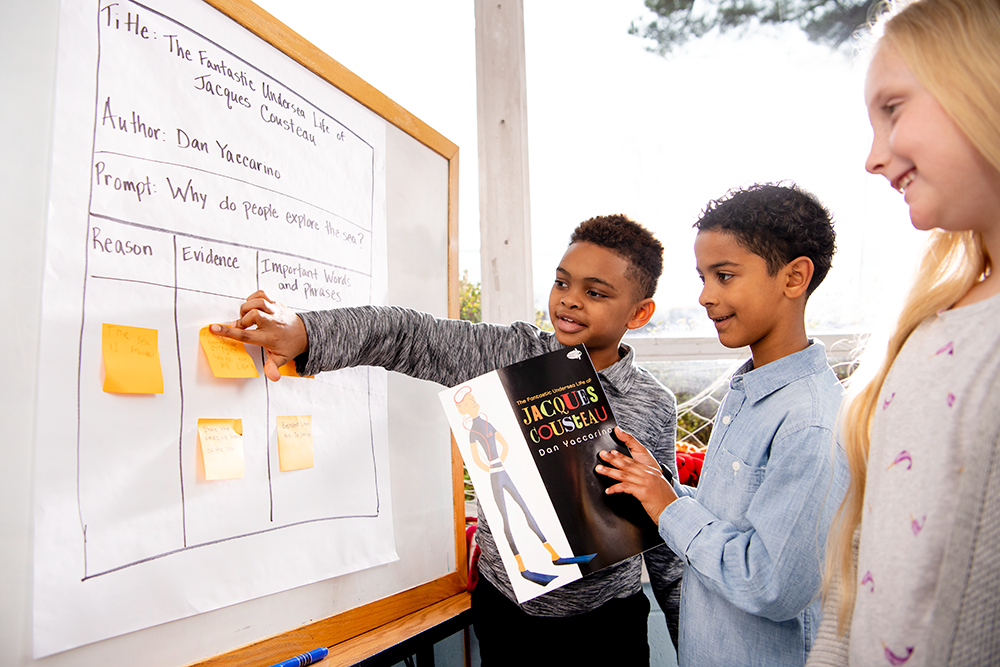Posted in: Aha! Blog > Wit & Wisdom Blog > Implementation Support > Reflecting and Refreshing for Social Emotional Learning
THIS MONTH’S FOCUS
“With the new day comes new strength and new thoughts.” –Eleanor Roosevelt
The new year offers a chance for a new beginning—to reflect, resolve, and refresh. January is the perfect time for teachers and students to build on what has gone well in the classroom and take stock of areas for improvement. Enough of the school year has passed for meaningful reflection—while over half of the school year remains for additional growth.
Given the unique events of the current school year, one of the most fruitful areas of reflection is students’ social-emotional learning. Students do best when educators integrate social-emotional learning across the school day. Research suggests that when students experience social-emotional success, teachers cite higher levels of professional satisfaction!
OVERVIEW
Research confirms what many of us know from our teaching and learning: Social-emotional development matters. Decades of research show that it can be taught and learned. Social-emotional development has a strong and positive impact on students’ relationships, academic performance, anxiety, behavior, attitudes, and perceptions. “Major domains of human development—social, emotional, cognitive, linguistic, academic—are deeply intertwined in the brain and in behavior. All are central to learning” (Jones and Kahn, The Evidence Base for How We Learn).
Social-emotional learning experts stress the importance of three critical, interconnected instructional moves:
- Community: creating a safe and caring learning community
- Support: making intentional efforts to help students meet their social-emotional needs
- Instruction: explicitly teaching and practicing needed social-emotional skills
Wit & Wisdom® supports teachers in successfully doing all three.
Community: Students learn best in communities where they feel safe, known, cared for, and respected. Think of successful communities you belong to—a book club, a family or friend group, a volunteer organization. What makes the community a worthwhile place to be? Most likely, the “what” includes at least some of the following:
✔️ a shared sense of purpose
✔️ a feeling of connection and shared experiences,
✔️ rituals and routines, and
✔️an explicit or implicit set of norms that lead to respectful, caring treatment.
Designed so that students explore meaningful topics through reading, discussing, and writing about the same texts, Wit & Wisdom provides the shared purpose and experience essential to a strong community. The curriculum also provides rituals and routines through repeated structures like the Content and Craft Stages and the use of predictable instructional routines. Through Module 0 and the explicit teaching of speaking and listening skills, Wit & Wisdom helps teachers establish a community in which dialogue is respectful and everyone’s voice is heard.
Support: Students can learn more when we meet their social-emotional needs. The basic social-emotional needs include a feeling of belonging in the school community, competence or significance within it, and a measure of autonomy or control over their learning. When we meet these basic needs, students engage more in their learning and exhibit other positive attributes such as persistence and cooperation.
Wit & Wisdom provides the building blocks for teachers to help students meet these needs. The curriculum’s commitment to equity helps bolster students’ sense of belonging. Students read and engage with the same content, which sends a strong signal to all that they belong and are an equal part of the learning community. Wit & Wisdom also fosters students’ sense of competence by explicitly teaching them the skills they need, such as the use of Craft Stages to teach the skills needed to speak and write about texts. Finally, Wit & Wisdom fosters students’ sense of autonomy through open-ended explorations such as noticing and wondering about texts, frequently offering choices for assignments, and teaching students to assess their work.
Instruction: The third area of needed instruction is the explicit teaching of social-emotional skills. Students do better educationally and interpersonally when they learn and can apply specific social-emotional skills. The Collaborative for Academic, Social, and Emotional Learning (CASEL), a leader in fostering social-emotional learning to advance equity and excellence in districts and schools nationwide, defines five primary social-emotional competencies as essential:
- Self-awareness: Developing self-awareness requires that students learn to recognize their emotions, thoughts, and values, connecting how these influence behavior, and learn to assess their strengths and limitations accurately. This self-awareness helps students develop confidence, optimism, and a growth mindset. In Wit & Wisdom, students develop these skills and understandings by
✔️ examining topics and texts that build self-knowledge;
✔️ engaging in productive struggle through rigorous, supported academic work; and
✔️ learning to evaluate their academic performance accurately.
- Social awareness: As they develop social awareness, students learn to take the perspective of and empathize with others, including those from diverse backgrounds and cultures, and to understand social and ethical norms for behavior. Wit & Wisdom students do so by
✔️ examining topics and texts in which real and fictional people from diverse backgrounds and cultures respond to opportunities and challenges, and
✔️collaborating with classmates on meaningful and authentic tasks.
- Self-management: Self-management encompasses varied skills and understandings. Students learn to make responsible choices about their learning and deepen their innate sense of curiosity as they explore compelling questions. They work on successfully regulating their emotions, thoughts, and behaviors in different situations—effectively managing stress, controlling impulses, and motivating themselves, as well as setting and working toward personal and academic goals. In Wit & Wisdom, students develop skill in self-management by
✔️ cultivating effective habits of mind, including persistence, flexible thinking, questioning, and evidence collection;
✔️ setting goals and making authentic choices about what or how to learn;
✔️ learning to value curiosity and inquiry; and
✔️ reflecting on learning and performance.
- Relationship skills: Explicit instruction in speaking and listening, authentic opportunities to communicate with classmates, and collaborative learning structures help students build relationship skills and work effectively with others to accomplish tasks. As students learn to communicate clearly, listen well, cooperate with others, and negotiate conflict constructively, they are able to establish and maintain relationships with diverse individuals and groups. Wit & Wisdom both explicitly and implicitly builds students’ relationship skills by
✔️offering explicit speaking and listening instruction,
✔️ including authentic opportunities to practice speaking and listening in collaboration with classmates on meaningful and authentic tasks, and
✔️ encouraging students to ask and answer questions and seek and offer help when needed.
- Responsible decision-making: Students who are responsible decision makers make constructive choices about personal behavior and social interactions based on ethical standards, safety concerns, and social norms. They realistically evaluate the consequences of various actions and consider their well-being and that of others. Wit & Wisdom students learn to make responsible choices in their learning overall and specifically in Socratic Seminars by
✔️ examining topics and texts in which real or fictional characters face challenging decisions,
✔️ engaging in open and respectful academic dialogue, and
✔️ learning to value evidence and logical reasoning.
Guidance
Teachers can build on the foundation Wit & Wisdom establishes to strengthen social-emotional learning. For a new year’s check-in and refresh, consider taking these actions:- Take stock.
- Strengthen the classroom community.
- Bolster students’ sense of belonging, competence, and autonomy.
- Zero in on needed social-emotional skills.
- Take care of your own social-emotional needs.
Take stock. Reflect on the first few months of the school year, looking specifically from the perspective of SEL. How strong does your classroom community feel? Are most students feeling a sense of belonging, competence, and autonomy? In which of the five CASEL competencies have you seen strength and growth among your students?
To further engage in assessment, you might ask more specific questions such as these:
- How well do students know each other?
- How are you using structures like the Content and Craft Stages to build rituals into learning?
- How well are your routines working, and how comfortable are students with the routines for learning?
- How well are the classroom routines fostering conversation?
- How safe do students feel sharing their ideas with others?
- How well are students taking ownership of their learning in each lesson or arc of lessons?
For a more formal self-assessment, see the CASEL site, which offers tools for teachers.
Strengthen the classroom community. If your reflection leads you to recognize the need to strengthen your classroom community, consider taking the following actions:
- Offer an explicit introduction to SEL concepts and their importance, if you have not already done this.
- Collaborate with your class to revisit your classroom norms and expectations, and update them as needed. If you have switched from in-person to virtual learning, consider setting more purposeful online etiquette guidelines. Engaging students in setting expectations helps them take ownership.
- If students participate less virtually than they did in person, consider ways to invite more discussion and participation. Look in the Wit & Wisdom lessons for specific opportunities for student talk, and then explore virtual options for engaging students in these opportunities. To break the ice in a virtual setting, engage all students in participation quickly, such as with a low-risk welcome sharing. Consider using breakout rooms in your online platform. Create an online space for whole group sharing, and encourage students to “like” other students’ posts and to respond respectfully and productively to each other’s posts. If you struggle to facilitate large conversations online, consider having small group discussions when possible or using a “fishbowl” approach where a small group of students engages in discussion while classmates contribute ideas through a Chat feature.
- Look for places to bring more joy and a sense of community into your classroom. For example, you can elevate lessons that include fluent recitations of module poetry or Readers’ Theater performances into opportunities—even virtually—to include families and caregivers or younger students from other classrooms. You might invite students to use or create props or costume elements to enhance their performances and add to the fun. Celebrate the completion of texts, Focusing Question arcs, or the end of modules by letting students share Knowledge Journal entries or otherwise represent what they loved learning in a given module. Consider collaborating with the art teacher to extend learning from the module’s core art text(s). For example, students might emulate the style or medium of the core art text. Collaborate with the music teacher to explore music from the time period or place of study.
Bolster students’ sense of belonging, competence, and autonomy. Perhaps your reflection on the first part of the year led you to worry that some or all students are not fully engaged with each other or with learning. If so, consider steps like the following:
- To bolster students’ sense of belonging, track your interactions with students or their interactions with each other, and check your own unconscious biases. For example, record yourself teaching and then watch and analyze the interactions. Do you call on certain students more than others? Do you scaffold more for certain types of students than others? Having someone else observe your teaching through the lens of equity and the need for all students to feel a sense of belonging is even more powerful, as others can often see what we cannot. Ask an administrator or trusted colleague to observe or watch a video of your teaching to see differences in how you interact with or treat students. Be open to their feedback, even if it is challenging.
- To ensure all students feel valued, keep a class list and mark each time you call on a student to share a response or their work. Be hyper-aware of dynamics that might diminish students’ sense of belonging, such as disparaging or allowing other students to disparage students’ observations and questions.
- To help students feel a deeper sense of competence, prioritize giving them chances to share their thoughts and completed work, either in class or through class displays. Periodically reflect with students on their growth, using the information in Wit & Wisdom’s criteria for success and rubrics to guide your reflection.
- To foster students’ sense of autonomy, ensure that they talk to each other rather than through you in conversations, to the extent possible. Also, use the guidance in Wit & Wisdom lessons to teach students to assess their work and give others meaningful feedback.
Zero in on needed social-emotional skills. In this challenging year, some social-emotional skills are even more essential than others. Once you have taken stock, prioritize the skills your students need most to succeed socially and emotionally:
- If students are less focused in your virtual work together, plan for how you might help them get into the right mental space for learning. Do you want them to be ready to reflect? Engaging in some brief breathing exercises might help. Do you want students energized for discussion? You might suggest five jumping jacks before discussion.
- If students are experiencing challenging emotions, elevate discussions that explore the real-life and fictional characters’ emotions and feelings in Wit & Wisdom texts. Invite students to engage in their initial responses to texts in new ways, such as drawing pictures and sharing emojis that reflect their reactions to texts.
- If students seem to be demonstrating a negative mindset, take steps to encourage them to engage in a different thinking process. Model the effort that goes into a successful performance by thinking aloud when you problem-solve or work to comprehend a new text. Try to avoid automatic praise, such as “Great job!” Instead, use words carefully to highlight the connection between effort and outcome. Model and encourage students to use positive word choices: “I do not know how to do this yet.” “Let us see what is going to happen.” “I wrote a clear topic statement but still need to work on adding evidence from the text to support it.”
Take care of your own social-emotional needs. Adults have the same needs as students, so make sure you foster your own sense of belonging in your school and classroom community, your sense of competence and significance, and your sense of autonomy as much as possible. Consider steps such as the following:
- Collaborate with colleagues. Sharing ideas and strategies with colleagues will bolster your sense of belonging and decrease the isolation many of us feel right now. Consider working with a colleague to celebrate learning, for example, by having students from each class share key learning with one another.
- Celebrate successes. Particularly in a year fraught with challenges, it can be easy to engage in deficit thinking. Try to reflect on and celebrate all that you and your students have accomplished so far this year—books students have read, the knowledge they have gained, the successful writing they have completed, and the skills they have built. If possible, journal each day, purposefully reflecting on positive moments.
- Avoid unhealthy comparisons. While we all strive to ensure students learn as much as possible, be careful not to hold unrealistic standards for yourself or your students. Be realistic about the constraints of this year while continuing to strive to reach all students.
Engaging families in social-emotional learning
The new year can also be an opportunity to refresh your communications with families and caregivers and ensure that lines of communication are open. Families and caregivers can support, reinforce, and add to the knowledge and skills students build in Wit & Wisdom. Open the new year by sharing the Family Tip Sheet for your current module if you have not done so already.
By now, you likely know what types of communications work best with different families—written or electronic communications or phone calls. Consider making one of your Wit & Wisdom journals a back-and-forth journal to build and maintain student-teacher-family communication. Recording a short new year’s welcome back video can be another way to reach families.
tips for fostering social-emotional learning
- Create rituals and routines. Many routines are already built into Wit & Wisdom lessons, such as noticing and wondering about a new text, participating in repeated instructional routines, and recording in the Knowledge Journal at the end of a module. You may also want to start each class with a breathing exercise or other personal check-in before launching the Welcome and Launch activities to help ground students before learning.
- Expectations for behaviors support students’ development of social awareness and self-management. Setting guidelines, such as using respectful language during Socratic Seminars, helps establish a culture of social awareness. Many Wit & Wisdom modules include Anchor Charts for speaking and listening or suggested sentence frames; keep these posted in a student-friendly location, whether virtual or in person, so that students can regularly check in on the guidelines.
- An organized learning space also fosters students’ self-management. Spend time with students one-on-one if possible, particularly during virtual learning, to discuss ideas about how to be organized with the materials needed for Wit & Wisdom, such as the student journals and the core texts.
- Establish guidelines and roles for breakout rooms, and provide time and structure for small group interactions to help students build relationship skills and strengthen the classroom community. Be sure when modifying Wit & Wisdom instruction for virtual learning not to eliminate opportunities for students to interact together; the classroom teacher recommendations in the Wit & Wisdom Learn Anywhere Plans (LAPs) provide additional guidance in this area.
- Encourage responsible decision-making by using language that connects achievement with effort and persistence. Highlight the choices that real-life people and fictional characters in the Wit & Wisdom core texts make, and discuss the consequences of those decisions.
- Wit & Wisdom often offers specific rubrics and checklists to support self-reflection. When students provide critiques of their own performance, encourage them to be specific and to set targeted goals for the next performance, such as in the goal setting after each Socratic Seminar. Include time for Knowledge Journal entries and discussion to provide more opportunities for self-reflection. Emphasize the importance of these opportunities to help develop students’ self-awareness as they build skills and knowledge in Wit & Wisdom.
“Hope smiles from the threshold of the year to come, whispering, ‘It will be happier.’”
–Alfred, Lord Tennyson
All of us at Great Minds® wish you and your students all the best in the new year.
resources for social-emotional learning
Collaborative for Academic, Social, and Emotional Learning (CASEL). “What Is SEL?”
https://casel.org/what-is-sel/.
Durlak, Joseph, et al. “The Impact of Enhancing Students’ Social and Emotional Learning:
A Meta-Analysis of School-Based Universal Interventions.” Child Development, vol. 82, no. 1,
2011, pp. 405–32, http://witeng.link/0963.
Jones, Stephanie M., and Jennifer Kahn. The Evidence Base for How We Learn: Supporting
Students’ Social, Emotional, and Academic Development. National Commission on Social,
Emotional, and Academic Development, The Aspen Institute, 13 Sept. 2017,
Payton, John, et al. “The Positive Impact of Social and Emotional Learning for Kindergarten to Eighth-
Grade Students: Findings from Three Scientific Reviews.” Collaborative for Academic, Social,
and Emotional Learning, 2008, http://witeng.link/0964.
Submit the Form to Print

Scott Dieter
Scott Dieter serves as one of Great Minds’ Regional Directors of Implementation Services for Wit & Wisdom, partnering with schools and districts across the Midwest to support their implementation of Wit & Wisdom and Geodes®. Before joining the Great Minds team, he was the Director of Early Childhood Education for Lorain City Schools. He is also a former kindergarten teacher and instructional coach. Scott is currently working on his M.A. in Reading Science from Mount St. Joseph University in Cincinnati, Ohio.
Topics: Featured Implementation Support











